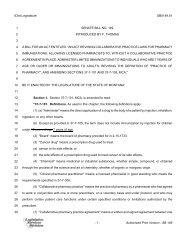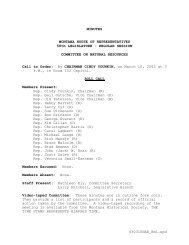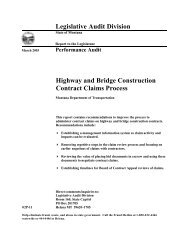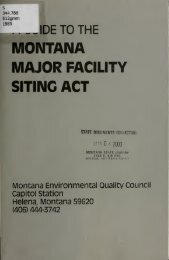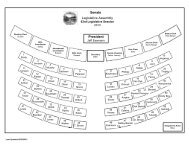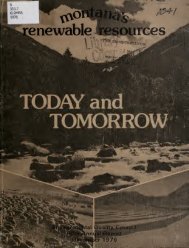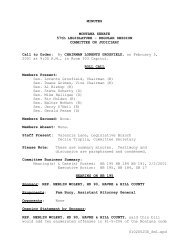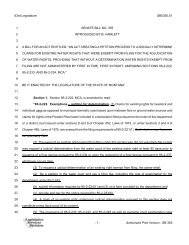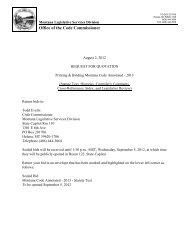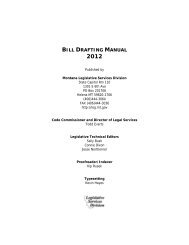Public Comment. Volume III - Montana Legislature
Public Comment. Volume III - Montana Legislature
Public Comment. Volume III - Montana Legislature
You also want an ePaper? Increase the reach of your titles
YUMPU automatically turns print PDFs into web optimized ePapers that Google loves.
Impact Analysis Studies and Proposed Mitigation Approach Page 7<br />
The original impact study outlined in the State's comments (May 4, 1999 letter from MT<br />
DNRC to TRRC) to the Womack study (1999) has been modified to allow it to take<br />
place on-site concurrently with normal production. This study will address potential<br />
impacts due to vibration, herbicide application, coal dust, derailment/spills, or any other<br />
conditions or situations related to TRRC activity. Responsibility for the study design and<br />
execution would be transferred to a third party, such as a graduate student or students<br />
under the supervision of a local university professor or other researcher, to ensure<br />
independence of findings and impartiality as well as to reduce overall costs. A description<br />
of the modified impact study is included as Attachment A (Vibration and Impact Studies)<br />
at the end of this document.<br />
The results of this study, combined with information about critical factors affecting<br />
hatchery production fiom the baseline study, should assist MT DFWP, TRRC, and the<br />
'. mitigation committee in distinguishing whether impacts can be attributed to TRR<br />
operation or to variations in hatchery conditions.<br />
3.2 Study Period<br />
3.2.1 Baseline Study.<br />
It is assumed that the baseline study will be initiated during the two years prior to<br />
TRRC's anticipated commencement of construction and will not delay that construction.<br />
Ideally, this study will not require alteration of hatchery operations, and additional data<br />
collection will be incorporated into the day to day routine. Once started, data collection<br />
will be continued through the entire construction period and at least two years into fill<br />
operation to develop a complete record of changes in circumstances and responses at the<br />
hatchery level. Thus, the baseline study and data gathering activities to document changes<br />
will span, at a minimum, a six year period. Detailed record keeping will also ensure that<br />
impacts will be detected as soon as possible, and that any losses will be kept to a<br />
minimum by timely response. Given that construction is slated to begin within the next'<br />
two to three years, the baseline study should begin this spring (2000). Because currency<br />
and continuity of data is important, if the study begins and then TRRC is unable to begin<br />
construction as scheduled, MT DFWP assumes that the baseline study will be fbnded<br />
continuously until two years after operation has begun.<br />
3.2.2 Impact Studies<br />
The vibration and impact studies should also take place before construction begins to<br />
avoid any confounding effect from TRRC construction activities or operations. However,<br />
since these experiments will be highly controlled and more laboratory based, there is no<br />
need for these to continue into the construction period. It is anticipated that two to.three<br />
years will be required for design, set-up, and data gathering for these studies. Additional<br />
time may be required for data analysis, but the goal is to have the final results in-hand<br />
before construction is complete.<br />
~ . ~ T I I l L I ~ u C r ? l dI.lr.M2bc<br />
r r l<br />
-228- <strong>Volume</strong> Ill: <strong>Public</strong> <strong>Comment</strong>



